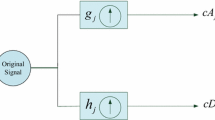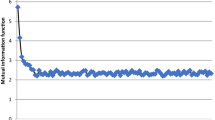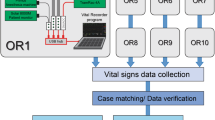Abstract
This paper presents a real-time algorithm for changes detection in depth of anesthesia signals. A Page–Hinkley test (PHT) with a forgetting mechanism (PHT-FM) was developed. The samples are weighted according to their “age” so that more importance is given to recent samples. This enables the detection of the changes with less time delay than if no forgetting factor was used. The performance of the PHT-FM was evaluated in a two-fold approach. First, the algorithm was run offline in depth of anesthesia (DoA) signals previously collected during general anesthesia, allowing the adjustment of the forgetting mechanism. Second, the PHT-FM was embedded in a real-time software and its performance was validated online in the surgery room. This was performed by asking the clinician to classify in real-time the changes as true positives, false positives or false negatives. The results show that 69 % of the changes were classified as true positives, 26 % as false positives, and 5 % as false negatives. The true positives were also synchronized with changes in the hypnotic or analgesic rates made by the clinician. The contribution of this work has a high impact in the clinical practice since the PHT-FM alerts the clinician for changes in the anesthetic state of the patient, allowing a more prompt action. The results encourage the inclusion of the proposed PHT-FM in a real-time decision support system for routine use in the clinical practice.





Similar content being viewed by others
References
Ansermino JM (2009) An evaluation of a novel software tool for detecting changes in physiological monitoring. Anest Analg 108(3):873–880
Basseville M, Nikiforov I (1987) Detection of abrupt changes: theory and applications. Prentice-Hall, Englewood Cliffs, NJ
Bifet A, Gavaldà à R (2009) Adaptive learning from evolving data streams. In: Proceedings of AESF Annu Tech Conf 78th international symposium on intelligent data analysis: advances in intelligent data analysis VIII, pp 249–260
Gama J et al (2004) Learning with drift detection. In: Bazzan ALC, Labidi S (eds) Advances in artificial intelligence—SBIA 2004. Lecture notes in computer science, vol 3171, pp 286–295
Gama J et al (2009) Issues in evaluation of stream learning algorithms. In: Proceedings of the 15th ACM SIGKDD international conference on knowledge discovery and data mining, pp 329–338
Gama J (2010) Knowledge discovery from data streams. Chapman and Hall/CRC, Boca Raton, FL
Gambús PL et al (2011) Modeling the effect of propofol and remifentanil combinations for sedation-analgesia in endoscopic procedures using an adaptive neuro fuzzy inference system (ANFIS). Anest Analg 112(2):331–339
Gambús P et al (2006) Modelling the interaction of propofol and remifentanil by means of an adaptive neuro fuzzy inference system (ANFIS). Eur J Anaesthesiol Suppl 23:123
Gan TJ et al (1997) Bispectral index monitoring allows faster emergence and improved recovery from propofol, alfentanil and nitrous oxide anaesthesia. Anesthesiology 87(4):808–815
Glass PS et al (1997) Bispectral analysis measures sedation and memory effects of propofol, midazolam, isoflurane, and alfentanil in healthy volunteers. Anesthesiology 86(4):836–847
Hartl C et al (2007) Change point detection and meta-bandits for online learning in dynamic environments. In: Conference Francophone sur l’apprentissage automatique. Cepadues, pp 237–250
Jensen EW et al (2008) Validation of the Index of Consciousness (IoC) during sedation/analgesia for ultrasonographic endoscopy. In: Proceedings of the annual international conference of the IEEE Engineering in Medicine and Biology Society, pp 5552–5555
Kifer D et al (2004) Detecting change in data streams. In: Proceedings of the thirtieth international conference on very large data bases, pp 180–191
Klinkenberg R (2004) Learning drifting concepts: example selection vs. example weighting. Intell Data Anal 8(3):281–300
Klinkenberg R, Joachims T (2000) Detecting concept drift with support vector machines. In: Proceedings of ICML-00, 17th international conference on machine learning, pp 487–494
Koychev I (2000) Gradual forgetting for adaptation to concept drift. In: Proceedings of ECAI workshop current issues in spatio-temporal reasoning, pp 101–106
Luginbuhl M et al (2002) Detection of awareness with the bispectral index: two case reports. Anesthesiology 96(1):241–243
Maloof M, Michalski R (2000) Selecting examples for partial memory learning. Mach Learn 41:27–52
Mashour G et al (2009) A novel electronic algorithm for detecting potentially insufficient anesthesia: implications for the prevention of intraoperative awareness. J Clin Monit Comput 23(5):273–277
Melek WW et al (2005) Comparison of trend detection algorithms in the analysis of physiological time-series data. IEEE Trans Biomed Eng 52(4):639–651
Minto CF et al (2000) Response surface model for anesthetic drug interactions. Anesthesiology 92:1603–1613
Monk TG et al (2011) Does depth of anesthesia monitoring improve postoperative outcomes?. Curr Opin Anesthesiol 24:665–669
Mouss H et al (2004) Test of Page-Hinkley, an approach for fault detection in an agro-alimentary production system. In: Proceedings of the 5th Asian control conference, pp 815–818
Page ES (1954) Continuous inspection schemes. Biometrika 41(1–2):100–115
Paz LA et al (2011) Integrated design system for monitoring digital processing and control in anesthesia. In: American Society of Anesthesiologists Annual Meeting 2011, abstract A1169
Rampil IJ (1998) A primer for EEG signal processing in anesthesia. Anesthesiology 89(4):980–1002
Sebastião R et al (2010) Monitoring incremental histogram distribution for change detection in data streams. In: Gaber MM, Vatsavai RR, Omitaomu OA, Gama J, Chawla NV, Ganguly AR (eds) Knowledge discovery from sensor data. Lecture notes on computer science, vol 5840, pp 25–42
Selbst SM (2000) Adverse sedation events in pediatrics: a critical incident analysis of contributing factors. Pediatr Int 105(4):864–865
Silva MM et al (2009) Total mass TCI driven by parametric estimation. In: Proceedings of the IEEE Mediterranean conference on control and automation, pp 1149–1154
Struys MM et al (2002) Performance of the ARX-derived auditory evoked potential index as an indicator of anesthetic depth: a comparison with bispectral index and hemodynamic measures during propofol administration. Anesthesiology 96(4):803–816
Viertiö-Oja H et al (2004) Description of the entropy algorithm as applied in the Datex-Ohmeda S/5 entropy module. Acta Anaesthesiol Scand 48(2):154–161
Yang P et al (2006) Adaptive change detection in heart rate trend monitoring in anesthetized children. IEEE Trans Biomed Eng 53(11):2211–2219
Acknowledgments
The work of Raquel Sebastião and Margarida M. Silva is supported by FCT (Portuguese Foundation for Science and Technology) under the PhD Grants SFRH/BD/41569/2007 and SFRH/BD/60973/2009, respectively. This work is also funded by the ERDF through the Programme COMPETE and by FCT through - projects GALENO - Modeling and Control for Personalized Drug Administration (PTDC/SAU-BEB/103667/2008) and KDUDS - Knowledge Discovery from Ubiquitous Data Streams (PTDC/EIA-EIA/098355/2008). This work is part-funded by the ERDF - European Regional Development Fund through the COMPETE Programme (operational programme for competitiveness), by the Portuguese Funds through the FCT within project FCOMP - 01-0124-FEDER-022701. The authors gratefully acknowledge Dr. Simão Esteves and his colleagues from Hospital Geral de Santo António (HGSA), Centro Hospitalar do Porto, Portugal and Dr. Manuel Seabra and his colleagues from Hospital Pedro Hispano, Unidade Local de Saúde de Matosinhos, Portugal, for their participation in the data collection and collaboration in the results analysis.
Author information
Authors and Affiliations
Corresponding author
Rights and permissions
About this article
Cite this article
Sebastião, R., Silva, M.M., Rabiço, R. et al. Real-time algorithm for changes detection in depth of anesthesia signals. Evolving Systems 4, 3–12 (2013). https://doi.org/10.1007/s12530-012-9063-4
Received:
Accepted:
Published:
Issue Date:
DOI: https://doi.org/10.1007/s12530-012-9063-4




